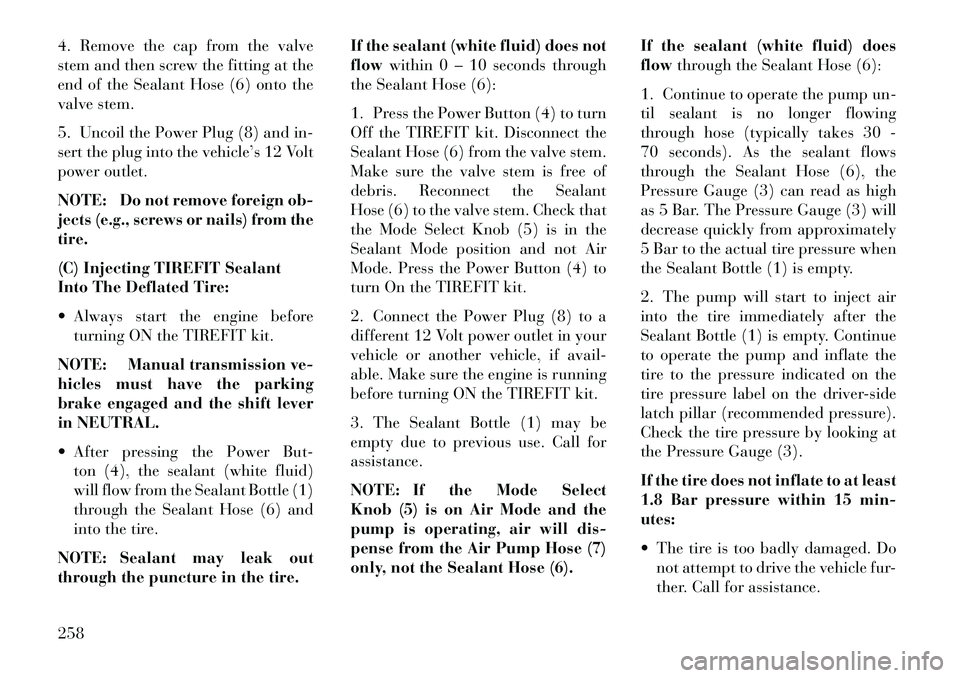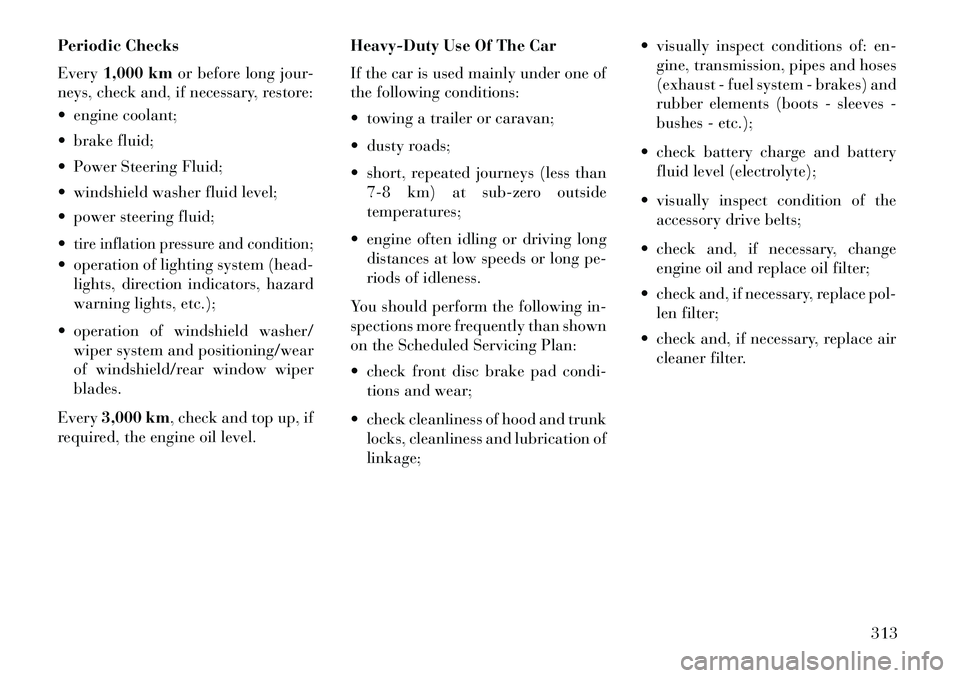run flat Lancia Thema 2013 Owner handbook (in English)
[x] Cancel search | Manufacturer: LANCIA, Model Year: 2013, Model line: Thema, Model: Lancia Thema 2013Pages: 336, PDF Size: 3.87 MB
Page 264 of 336

4. Remove the cap from the valve
stem and then screw the fitting at the
end of the Sealant Hose (6) onto the
valve stem.
5. Uncoil the Power Plug (8) and in-
sert the plug into the vehicle’s 12 Volt
power outlet.
NOTE: Do not remove foreign ob-
jects (e.g., screws or nails) from the
tire.
(C) Injecting TIREFIT Sealant
Into The Deflated Tire:
Always start the engine beforeturning ON the TIREFIT kit.
NOTE: Manual transmission ve-
hicles must have the parking
brake engaged and the shift lever
in NEUTRAL.
After pressing the Power But- ton (4), the sealant (white fluid)
will flow from the Sealant Bottle (1)
through the Sealant Hose (6) and
into the tire.
NOTE: Sealant may leak out
through the puncture in the tire. If the sealant (white fluid) does not
flow
within 0 – 10 seconds through
the Sealant Hose (6):
1. Press the Power Button (4) to turn
Off the TIREFIT kit. Disconnect the
Sealant Hose (6) from the valve stem.
Make sure the valve stem is free of
debris. Reconnect the Sealant
Hose (6) to the valve stem. Check that
the Mode Select Knob (5) is in the
Sealant Mode position and not Air
Mode. Press the Power Button (4) to
turn On the TIREFIT kit.
2. Connect the Power Plug (8) to a
different 12 Volt power outlet in your
vehicle or another vehicle, if avail-
able. Make sure the engine is running
before turning ON the TIREFIT kit.
3. The Sealant Bottle (1) may be
empty due to previous use. Call for
assistance.
NOTE: If the Mode Select
Knob (5) is on Air Mode and the
pump is operating, air will dis-
pense from the Air Pump Hose (7)
only, not the Sealant Hose (6). If the sealant (white fluid) does
flow
through the Sealant Hose (6):
1. Continue to operate the pump un-
til sealant is no longer flowing
through hose (typically takes 30 -
70 seconds). As the sealant flows
through the Sealant Hose (6), the
Pressure Gauge (3) can read as high
as 5 Bar. The Pressure Gauge (3) will
decrease quickly from approximately
5 Bar to the actual tire pressure when
the Sealant Bottle (1) is empty.
2. The pump will start to inject air
into the tire immediately after the
Sealant Bottle (1) is empty. Continue
to operate the pump and inflate the
tire to the pressure indicated on the
tire pressure label on the driver-side
latch pillar (recommended pressure).
Check the tire pressure by looking at
the Pressure Gauge (3).
If the tire does not inflate to at least
1.8 Bar pressure within 15 min-
utes:
The tire is too badly damaged. Do not attempt to drive the vehicle fur-
ther. Call for assistance.
258
Page 272 of 336

TOWING A DISABLED VEHICLETowing ConditionWheels OFF the Ground ALL MODELS
Flat Tow NONEIf transmission is operable:
Transmission inNEUTRAL
48 km/h maxspeed
24 km maxdistance (5-speed trans)
48 km maxdistance (8-speed trans)
Wheel Lift
Front
Rear OK
Flatbed ALLBEST METHOD
Proper towing or lifting equipment is
required to prevent damage to your
vehicle. Use only tow bars and other
equipment designed for the purpose,
following equipment manufacturer’s
instructions. Use of safety chains is
mandatory. Attach a tow bar or other
towing device to main structural
members of the vehicle, not to bum-
pers or associated brackets. State and
local laws applying to vehicles under
tow must be observed.If you must use the accessories (wipers,
defrosters, etc.) while being towed, the
ignition must be in the ON/RUN posi-
tion, not the ACC position.
If the vehicle's battery is discharged,
see “Shift Lever Override” in “What
To Do In Emergencies” for instruc-
tions on shifting the automatic trans-
mission out of the PARK position for
towing.CAUTION!
Do not use sling type equipment when towing. Damage to the fas-
cia will occur.
When securing the vehicle to a flatbed truck, do not attach to the
front or rear suspension compo-
nents. Damage to your vehicle
may result from improper towing.
(Continued)
CAUTION!(Continued)
Do not push or tow this vehicle with another vehicle as damage to
the bumper fascia and transmis-
sion may result.
The manufacturer does not rec- ommend towing this vehicle using
a tow dolly. Vehicle damage may
occur.
The manufacturer does not recom-
mend that you tow this vehicle on a
tow dolly. Vehicle damage may occur.
The manufacturer recommends tow-
ing your vehicle with all four wheels
OFF the ground using a flatbed.
266
Page 319 of 336

Periodic Checks
Every1,000 km or before long jour-
neys, check and, if necessary, restore:
engine coolant;
brake fluid;
Power Steering Fluid;
windshield washer fluid level;
power steering fluid;
tire inflation pressure and condition; operation of lighting system (head- lights, direction indicators, hazard
warning lights, etc.);
operation of windshield washer/ wiper system and positioning/wear
of windshield/rear window wiper
blades.
Every 3,000 km, check and top up, if
required, the engine oil level. Heavy-Duty Use Of The Car
If the car is used mainly under one of
the following conditions:
towing a trailer or caravan;
dusty roads;
short, repeated journeys (less than
7-8 km) at sub-zero outside
temperatures;
engine often idling or driving long distances at low speeds or long pe-
riods of idleness.
You should perform the following in-
spections more frequently than shown
on the Scheduled Servicing Plan:
check front disc brake pad condi- tions and wear;
check cleanliness of hood and trunk locks, cleanliness and lubrication of
linkage; visually inspect conditions of: en-
gine, transmission, pipes and hoses
(exhaust - fuel system - brakes) and
rubber elements (boots - sleeves -
bushes - etc.);
check battery charge and battery fluid level (electrolyte);
visually inspect condition of the accessory drive belts;
check and, if necessary, change engine oil and replace oil filter;
check and, if necessary, replace pol- len filter;
check and, if necessary, replace air cleaner filter.
313